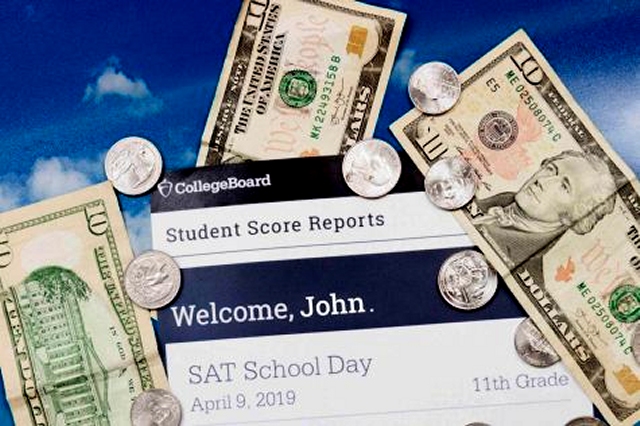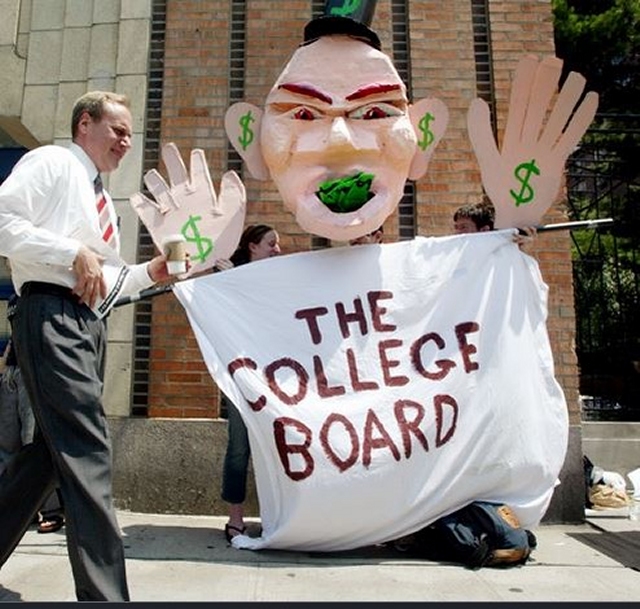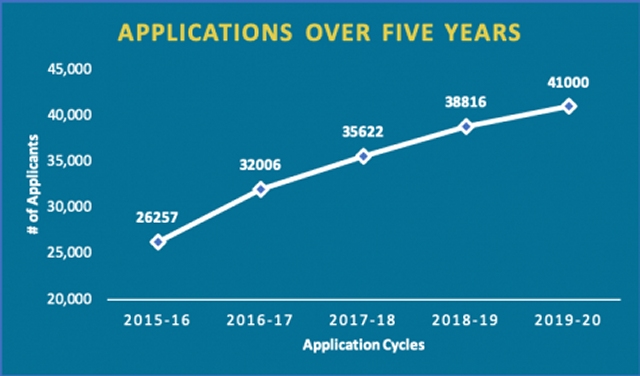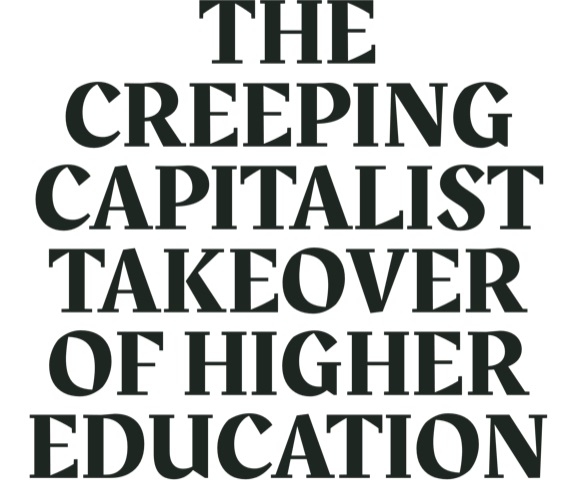
Think it’s a joke? That the keepers of the educational flame like University of Chicago, Stanford, Vanderbilt and other top-ranked institutions don’t have it in their DNA to lie, cheat and steal. Aren’t they non-profits with mission statements testifying to the purity of their motives? Any resemblance to the crime spree where hundreds of hapless investors lost a lifetime of savings never imagining they were in the grip of a master Mafioso: Bernie Madoff is purely coincidental.
Consider the plight of Joni J., a high school senior who drank the higher education hemlock to her everlasting disappointment—
| Although she became the valedictorian of her class, her scores on the practice SAT were below the average scores of students admitted to elite universities. Imagine her delight when she received brochures from Stanford, the University of Chicago and Vanderbilt. She was elated and spent over $250 applying to those schools and other elite universities that had also sent her brochures. All of them turned her down “A lot of the rejections came on the same day. I just stared at my computer and cried.” |
This scam doesn’t have anything to do with a bunch of rich parents indicted in “pay to play” schemes to get their kids to the front of the college admission line. This boondoggle is a lot bigger and more vicious—a conspiracy between the two major players in the higher education sweepstakes — the guardians at the gate (the College Board) and the keepers of the flame (elite colleges and universities).

Conspirator #1 is the non-profit College Board which has a monopoly on pre-admission standardized test-taking. Every year 2-2 ½ million students plunk down $49.50 ($84.50 for the SAT with an essay question) On test day students are asked to fill out a survey from the Student Search Service at the urging of College Board employees — “the Student Search Service helps you [the student] learn about different colleges – get information on application processes, financial aid, and campus life.” As one young woman who had completed the survey surrendering a load of personal information tearfully explained “schools that were interested in [me] would send mail.” Until the rejections started flooding her mailbox, it never occurred to her that “[my] data would be monetized.”
It’s not just harmless propaganda but a cruel hoax perpetrated on young people — “…these children are being profiled, stereotyped, and their data profiles are being traded commercially for all sorts of uses — including attempts to manipulate them and their families.” (Fordham Law School Professor Joel Reidenberg)
The College Board is a prime example of how richly scoundrels are rewarded. In 2017, College Board’s revenues totaled $1 billion, their profit $140 million, their assets $1.1 billion. Eighteen of their top executives made a combined total of $7 million, with their two top honchos making more than $1 million apiece. (College Board 2017 federal 990 return) All that money doesn’t come from administering tests. For over forty-eight years, the College Board has had a side hustle —selling student information, including name, ethnicity, parents’ education level and approximate SAT score to elite colleges and universities. At 47¢ a name with 1,900 colleges and universities participating, the profit implications are mammoth. Hard to know how much this scam adds to the College Board’s bottom line as officials there will not break out the total names it sells in a year nor the specific income. Word on the street is — jaw-dropping.

But that’s only half the story. This fraud would not be possible without the active participation of elite colleges and universities. According to Terry Cowdrey, an enrollment consultant and ex-acting dean of undergraduate education at Vanderbilt University — “They [colleges and universities] are buying some students’ names who don’t have a great chance of getting in… to increase the number of applications; you’ve got to keep getting your denominator up for your admit rate.” Look at how Vanderbilt’s reputation for exclusivity went into high gear as they upped the amount of student data they bought from the College Board. Their admit rate declined from 46% in 2002 to 11% for the class of 2021, their applicant pool climbed from 9,836 for the 2006 graduating class to 31,462 for the class of 2021. Based on what appeared to be their increased selectivity, their standing in the rankings went from the middle of the pack to 15. The lower the admit percentage the better the colleges and universities do in the ratings. The top five nationally ranked colleges and universities admit only 4-7% of applicants.
U.S. News & World Report, the national rankings czar, told it like it is — “A school’s academic atmosphere is influenced by the selectivity of its admissions.” The whole system from the college board that sells the names to the colleges and universities that buy them to the magazine that rates them depends on convincing students and parents that this phony baloney ranking system is a true indication of a school’s worth.
And the winners are —the College Board that makes millions on this side hustle. The colleges that make out equally well as they rise in the rankings, become known as exclusive and profit from a giant bounce in their ranking. Personal enrichment is also on the table. College presidents are being rewarded for this “innovative” approach to grow their rankings. The presidents of schools that have seen a sharp increase in their ratings like Northwestern (9), Vanderbilt (15) and the University of Chicago (6), reward these presidents with compensation of $1.5 million or more.
Where there are winners, there are bound to be losers. Many students, caught in the net of the college admissions fraud, apply to all the colleges that have contacted them… an expensive delusion. Each application costs, on average, $50 with at least 50 Ivy League colleges charging $75. Stanford charges $90. In 2018, Stanford admitted 4.36% of the students who applied.
Take heart future college students, the College Board-elite university boat appears to be taking on water. About one-quarter of schools have stopped requiring any form of standardized test on the grounds it favors upper-middle class kids and flunks as a predictor of future achievement. Currently a Los Angeles-based civil rights coalition is pressuring the University of California to drop the test requirement in admissions decisions for the 280,000 students it admits annually.
Even better, in December, 2019 an Illinois dad sued the College Board claiming his daughter’s personal information was sold to third parties without permission. Although the Student Search Service was an optional survey, students were encouraged to fill it out to “guide your counselors in helping you plan your future…” The sad truth — “While students were made to believe the results of these tests would significantly impact their futures, to Defendant College Board the tests served a wholly different purpose – i.e., to obtain highly valuable personal student information.” (From the suit)
U.S. students are getting it from both ends. Paying outrageous fees ($50 to $90 per application) to apply to colleges that will never admit them, paying to take SAT tests multiple times (at $49.50/ try) to raise their scores and then after graduating face crippling and oftentimes life-long debt. The majority of graduates (70%) take out student loans and collectively owe more than $1.5 trillion. Students in the Class of 2018 are fighting to keep afloat with an average debt of $30,000.

A whole generation of America’s future citizens and leaders will delay buying a home, getting married and starting a family. They will wait longer to buy a new car or make other major purchases. When many of them retire, they may find their Social Security income cut by the amount of debt they still owe. The economic consequences of their debt load will in one way or another hurt all Americans. A robust economy with 1 in 4 Americans struggling with student debt? Not likely. America has always been proud of its tradition of free public education and up until the middle of the twentieth century, college was part of the deal. Then the tenets of the free market hit higher education and everyone involved began to get greedy. Of many alternatives, squeezing student victims was a sure-fire road to the good life.
We’ve donned our Delphic Oracle hat to predict what will happen if the 2020 election doesn’t put a president in the White House who honestly believes in free college tuition and erasure of college debt for all Americans. Income criteria and other roadblocks to free college don’t make the cut. It’s time to let the educational Mafia know “We’re mad as hell and we’re not going to take it anymore.”
P.S. Want to learn more about the big con in higher education? You’ll find it here and here.
1,227 total views, 1 views today
